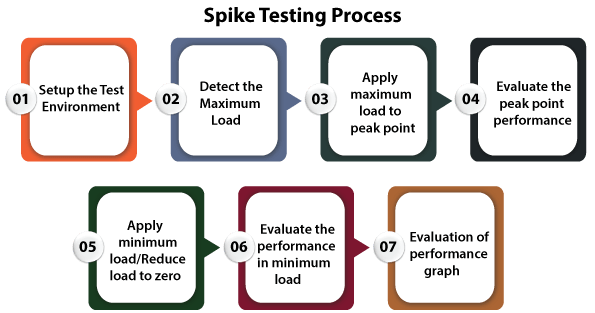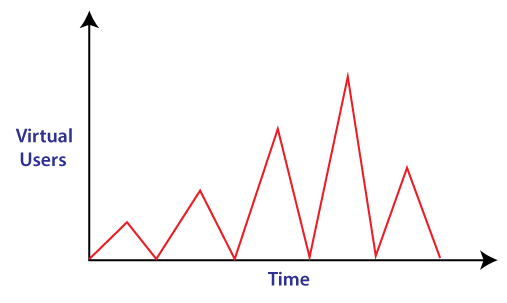Spike TestingIn this section, we are going to understand Spike testing, which is an essential part of Software testing. And we also learn about its needs, the purpose of Spike testing, why we need to perform the spike testing, the process of Spike testing, spike testing tools, and the advantage and disadvantages. Introduction of Spike TestingAs we learned earlier, the testing process is the essential part of SDLC, which evaluates the multiple software components like speed, scalability, and dependability. It is a subcategory of stress testing that guarantees that the developed application works under enhanced and reduced load created by n-numbers. And the system's performance is detected. It ensures that no issue won't occur in the speed of software, constancy, and scalability after the product's delivery. In other words, we can say that the spike testing is performed to check how essentially the system responds with unpredicted increases and failure of users. The objective of the Spike TestingThe significant objective of spike testing are as follows:
Spike testing ProcessSpike testing is vital and is mostly done to test how a system reacts when there is an unpredicted change in user load. The spike testing procedure involves continuous monitoring. It evaluates the application's vulnerability and checks its affected performance when there are a rapid enhancement and reduction of its load. Throughout the process of software development, the spike testing is implemented in a precise environment. Therefore, the spike testing process aims to extend an application's maximum capacity to make sure the ideal user involvement. The spike testing process completed in the below steps, which are as follows:

Step1: Set up the Test EnvironmentThe first step of the spike testing process is setting up the test environment, which depends on the various parameters in the business needs. The test environment setup is necessary to perform a successful test and retrieve a fair quality testing process. And we also ensure that no one is using the live environment to execute the spike testing in an application. Step2: Detect the Maximum LoadAfter finish setting up the environment, the maximum load is initiated; a system can prevent and detect the full load size of the application or the software product, which has developed. Here, the maximum load is the excessive number of users simultaneously using the system or the application. Step3: Apply maximum load to the peak pointIn the next step, we will enhance the load abruptly for a particular time, and after that, we will try to apply the maximum expected load to the peak point with the help of any performance tools. Step4: Evaluate the peak point performanceOnce the maximum load is applied to the peak point, we will evaluate the performance detected under the load on the peak point. It is used to check whether the system fails or survives under this unexpected increase. Step5: Apply minimum load/ Reduce the load to zeroAfter that, we will decrease the load slowly to the lowest (zero to minimum load). The process is also executed rapidly, which means that the load is reduced from highest value to lowest possible value. Step6: Evaluate the performance in minimum loadIn this step, we will evaluate the performance under the minimum load to see whether the system survives or fails under this unexpected reduce load. Step7: Evaluation of Performance graphIn the last step, the analysis of performance graph is done by seeing the metrics like virtual users, failures, and time-taken, etc. The evaluation of the performance graph is essential for the test engineer in detecting when the application has undergone crashes, and reporting back to the developers to fix the issue depends on that. 
Spike Testing ToolsWe have multiple spike tools available in the market, where some of them are open- sources and some of them are licensed tools. And each tool has its functionality, and approaches. Some of the most commonly used spike tools are as follows:
Apache JMeterApache JMeter is the most famous open-source tool in automation testing. It is mainly used to test the performance of both static and dynamic resources and dynamic web applications. It can reproduce the extensive load on an object, server, and network to discover the complete performance in multiple load types. It helps the developers or the users to use the source code for the development of other applications. 
Characteristic of JMeter Some of the significant features of JMeter tools are as follows:
For more information about JMeter, refers to the below link: https://www.javatpoint.com/jmeter-tutorial. LoadRunnerAnother spike testing tool is LoadRunner, which supports spike testing for the extensive range of protocols, number of technologies, and application environments. It quickly identifies the most common causes of performance issues. And precisely predict the application scalability and capacity. 
Characteristic of LoadRunner Below are the features of the LoadRunner tool:
Benefits and Drawback of Spike TestingFollowing are the advantages and disadvantages of spike testing: Advantage of Spike TestingSome of the significant advantages of Spike testing are as follows:
The Drawback of Spike TestingFollowing are the disadvantage of not executing the stability testing on the system under test:
OverviewIn this tutorial, we understood the significance of spike testing in SDLC (Software Development Life Cycle). We have also discussed the spike testing process, benefits, drawbacks and standard defects, etc. We can say that the Spike testing helps us to find the extreme load and standard issues that can occur once the enhancement in load is applied. Additionally, spike testing helps in confirming the software system's existing boundaries in the current effective environment. The correct method to perform spike testing is to suddenly enhance users' numbers, followed by an instant reduction in the load. Spike testing's primary focus is to detect the unexpected load and prepare the application to work on such conditions. The spike testing is mainly used to maintain the quality and the performance of the application or the software product. Hence, if we implemented the spike testing in the initial stage of the Software testing process, we can verify its behavior and capabilities. JMeter and LoadRunner are the most commonly used tools for spike testing.
Next TopicNegative Testing
|
 For Videos Join Our Youtube Channel: Join Now
For Videos Join Our Youtube Channel: Join Now
Feedback
- Send your Feedback to [email protected]
Help Others, Please Share










